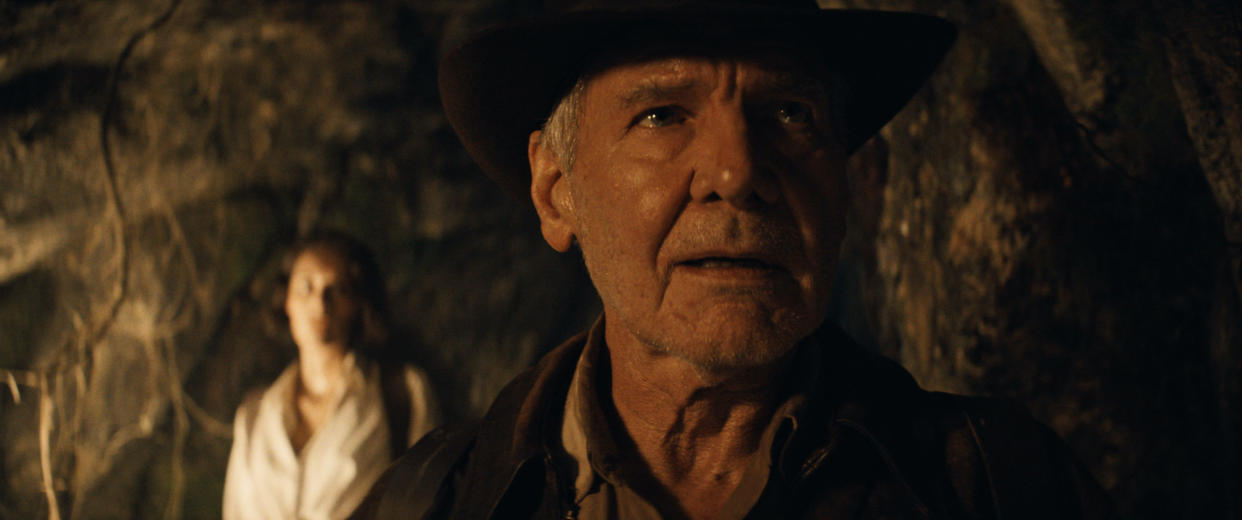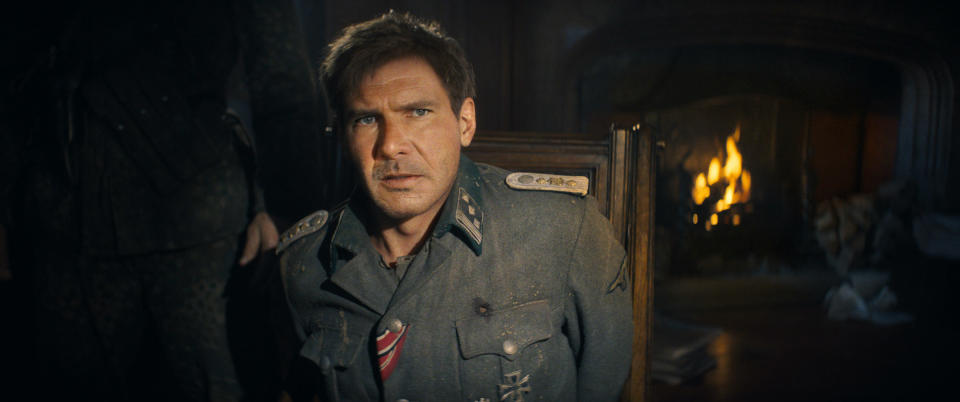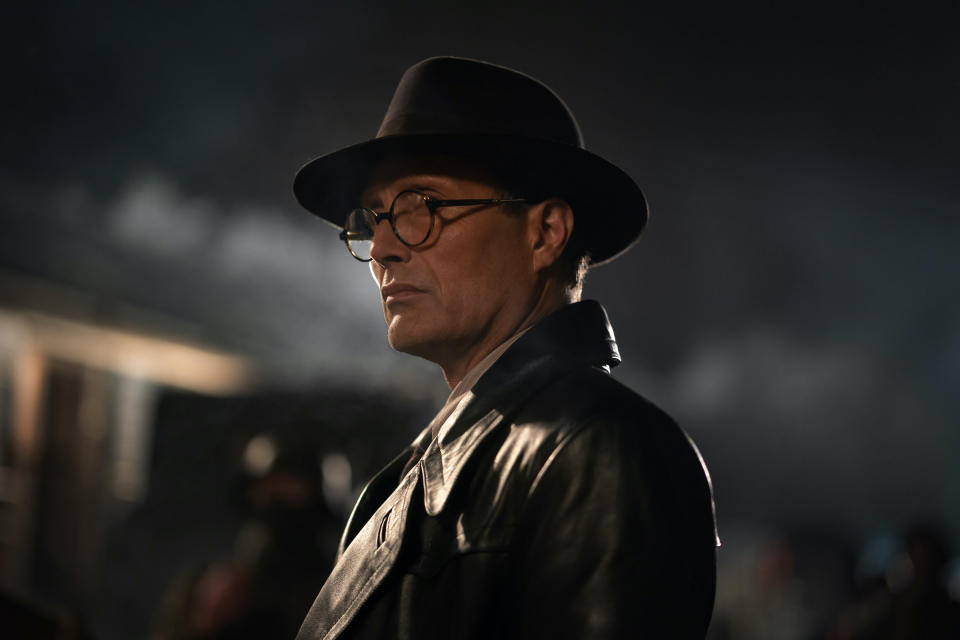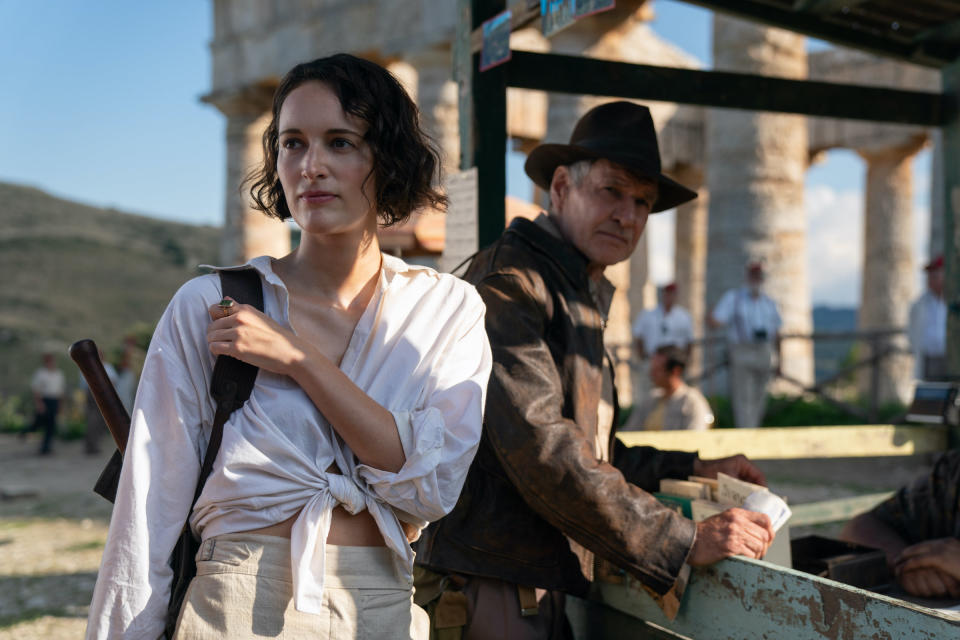Indiana Jones and the Dial of Destiny May Be Lackluster But Harrison Ford Is Forever

- Oops!Something went wrong.Please try again later.
- Oops!Something went wrong.Please try again later.
- Oops!Something went wrong.Please try again later.
Harrison Ford bids farewell to the role he originated in 1981 Credit - Courtesy of Lucasfilm
Harrison Ford is known to flummox journalists by being less than forthcoming in interviews; in public appearances, he tends to radiate an “I don’t really want to be here” vibe. Which is why it meant something to see him take the stage just ahead of the Cannes premiere of Indiana Jones and the Dial of Destiny on Thursday night, with tiny glimmers of almost-tears in his eyes. Cannes head Thierry Fremaux had introduced Ford by showing a highlight reel of his long, prismatic career, from American Graffiti to The Mosquito Coast to Bladerunner and beyond. It must be strange to sit there in a tux and watch your various incarnations across decades flash past you on a screen—it’s probably true that when you’re a movie star, others are more attuned to the natural changes in your face than you are. No wonder Ford, now 80, seemed moved by the tribute. “You know, I love you too,” he said to the audience after the applause had waned. “You give my life purpose and meaning, and I’m grateful for that.”
Ford is, pretty much, the best thing about James Mangold’s Indiana Jones and the Dial of Destiny, the fifth film in the franchise. The first, Steven Spielberg’s 1981 Raiders of the Lost Ark, was inspired by adventure serials of the 1930s and ’40s—the idea had been conceived by George Lucas and Philip Kaufman, with Spielberg later joining the project. In 1981, looking back at movies from 50 years earlier felt like gazing through the wrong end of the telescope; all the movie’s lo-fi hi-fun touches—its fixation on ancient golden gewgaws, slithery snakes and clearly labeled cartoon bad guys—seemed so mistily far away from what the movies had become by that time. Now, in 2023, when filmmakers have tons of new technology at their disposal, it’s easier than ever to make stuff look old-timey. (This new installment is set in 1969, around the time of the lunar landing.) By this point, any Indiana Jones picture is going to have almost too many layers of meta-nostalgia to sift through, though it’s also more likely to foster fond memories of your old, busted childhood VCR than it is to conjure Buck Rogers or Zorro’s Fighting Legion. That’s not a good thing or a bad thing; it’s merely a thing. But it does make you think about how readily your own cherished vision of the past can be used as a marketing tool, and how, increasingly and for some good reasons, we yearn to be returned to olden times that aren’t really even that old.

Yet Dial of Destiny creaks under the weight of the franchise’s stature. The movie’s opening flashback scenes give us a much younger Indiana Jones, in the form of a digitally de-aged Harrison Ford. He looks reasonably realistic—there’s nothing too terribly Hall of Presidents about him—but the effect is disconcerting even so, especially following the tribute reel the audience at the Cannes premiere had just seen, where the younger Ford had been brought to life before our eyes. That’s part of the wonder of movies: you can always go back to look at the Bette Davis of the 1930s and 1940s, the Montgomery Clift of the 1950s, and see the beauty of youth played back for you, even long after a star is gone. The de-aging technique used in Dial of Destiny scanned reams of footage from every Lucasfilm in which Ford had ever appeared, in addition to outtakes, to pick up various angles of his younger face in every possible permutation of lighting. Such an efficient tool! But efficiency isn’t the same as magic.
In the de-aged portion of Dial of Destiny, we catch up with Indiana as World War II winds down. Hitler has retreated to his bunker; the end seems near. A bunch of Nazi heavies see what’s coming and try to skate off with a bunch of looted art and artifacts, and the youngified anthropologist Indy needs to stop them. It’s here that we meet the story’s marvelously villainous villain, Mads Mikkelsen’s Jürgen Voller, an adorably nerdy physicist in Clark Kent glasses. Too bad he’s a Nazi.

In this early part of the film, we also meet Indiana’s pal Basil Shaw (Toby Jones), an academic whose eyes gleam at the mere mention of the story’s object of desire, the dial-thingie of the title, an important-looking doodly-doo—invented by Archimedes— that can locate fissures in time. Everybody wants it, most of all Voller. We watch in something that’s supposed to approximate awe, but doesn’t quite, as Indiana and Toby face off against Voller and various other Nazi thugs atop a train speeding through the European countryside. It’s as thrilling as any clatteringly fake CGI-heavy scene can be.
It’s also a harbinger of what’s to come. There are so many chase sequences in Dial of Destiny that the movie seems held together with slender bits of plot, rather than the other way around. Worse yet, they’re so heavily CGI’ed that they come off as grimly dutiful rather than thrilling or delightful. After about a half hour of Nazi-era setup, we finally get to meet the Indiana Jones of the late 1960s, who looks as Harrison Ford actually does now—phew! Just as he’s retiring from Hunter College, where he’s been a revered archaeology professor, he’s drawn out of retirement when Basil Shaw’s grown daughter Helena (Phoebe Waller-Bridge), now a brainy archaeologist type herself, first charms him as a means of procuring the dial of whatever, and then runs off with it. Then the slippery Voller shows up: he wants it too, now more than ever. It’s important to note, though, that this is only half of the dial; you’ve got to have something to look for in an Indiana Jones movie.

As Helena, Waller-Bridge, with her Tommy Tune-like legs and daffily expressive eyes, is one of the movie’s better natural effects. But even she gets lost in the overly complex plot, which involves world travel from New York to Tangiers to Athens to Sicily that should be exciting but isn’t (aside from the little old-style cartoon maps used to trace the adventurers’ perambulations, which are adorable). And then there are those interminable chase scenes. In New York, on the run from somebody or other during an Apollo 11 celebratory parade, Indy rides a horse right into the 59th Street station and onto the tracks—directly in the path of a speeding subway train. We see how he gets out of this one, sort of. But the narrow escape doesn’t make visual sense. It’s a case of being signaled that something is truly, madly astonishing but failing to deliver the actual goods.
The movie’s best scenes are the more modest ones that remind us what we loved about the earlier movies—the way, for example, a host of creepy-crawlies come clattering down the walls of a cave, inquisitive and menacing at once. But there’s also a murky underwater sequence and, one of the movie’s worst sins, a tragically underused Antonio Banderas as ace undersea diver Renaldo. The best thing about Indiana Jones and the Dial of Destiny is its ending, a reunion of characters that anybody who has any affection for the franchise is probably longing to see. And it’s here that Ford—with his current-day face, marked by all the actual living that goes into a life—is at his best, showing the kind of gruff, reluctant tenderness that’s become one of his trademarks. He’s already got the best face money, or technology, can’t buy.

